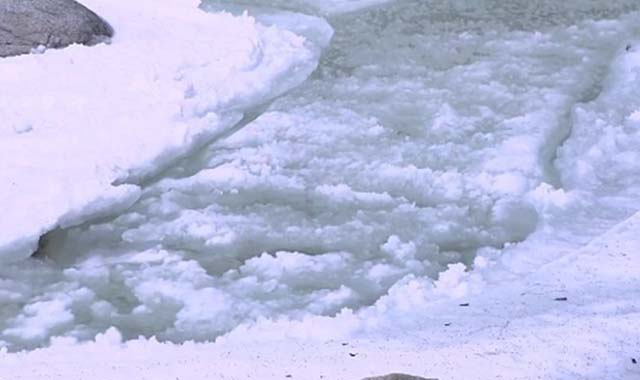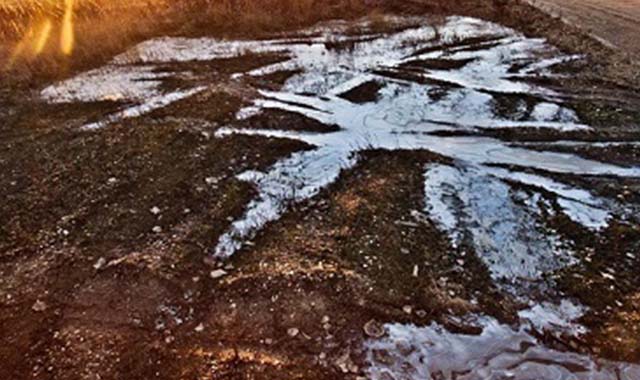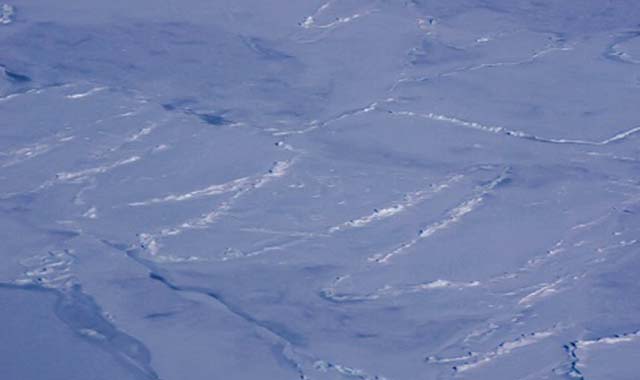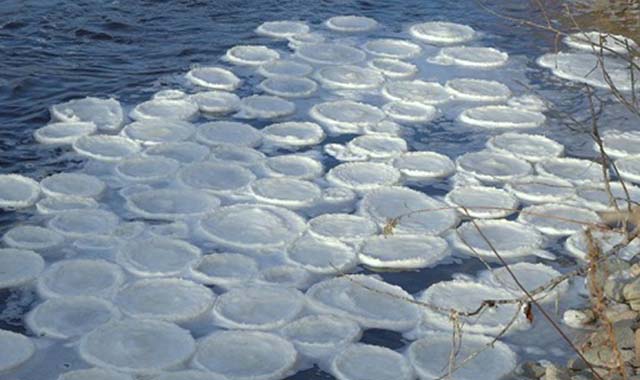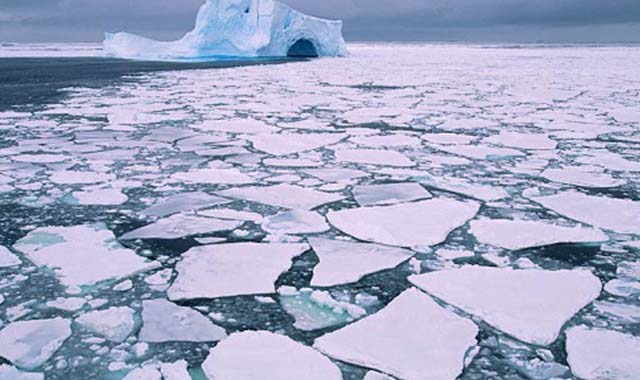TYPES OF SEA ICE:
- NEW ICE: A General Term For Recently Formed Ice Which Includes Spicules (Frazil Ice), Grease Ice, Slush And Shuga.
- NILAS: Is An Elastic Crust Of High Salinity, Up To 10 Centimeters In Thickness, With A Matte Surface Develops.
- YOUNG ICE: Is The Transition Stage Between Nilas And First-year Ice, 10–30 Cm In Thickness. May Be Subdivided Into Grey Ice And Grey-white Ice.
- GREY ICE: Young Ice 10–15 Cm Thick. Less Elastic Than Nilas And Breaks On Swell. Usually Rafts Under Pressure.
- GREY-WHITE ICE: Young Ice 15–30 Cm Thick. Under Pressure More Likely To Ridge Than To Raft.
- FIRST-YEAR ICE: Sea Ice Of Not More Than One Winter’s Growth, Developing From Young Ice; Thickness (Typically) 0.3–2 M. May Be Subdivided Into Thin First-year Ice/white Ice, Medium First-year Ice And Thick First-year Ice.
- OLD ICE: Sea Ice Which Has Survived At Least One Summer’s Melt. Topographic Features Generally Are Smoother Than First-year Ice. It Maybe Subdivided Into Second-year Ice And Multiyear Ice.
- SECOND-YEAR ICE: Old Ice Which Has Survived Only One Summer’s Melt. Because It Is Thicker And Less Dense Than First-year Ice, It Stands Higher Out Of The Water. This Term Is Seldom Used Today
- MULTI-YEAR ICE: Old Ice Up To 3 Metres Or More Thick Which Has Survived At Least Two Summers’ Melt. It Is Almost Salt-free. Colour, Where Bare, Is Usually Blue.
FORMATION OF SEA ICE:
FRAZIL ICE: Is The First Indication Of The Formation Of New Sea Ice Is The Development Of Small Individual, Needle-like Crystals Of Ice, Which Become Suspended In The Top Few Centimeters Of Seawater. These Spicules, Give The Sea Surface An Oily Appearance.
GREASE ICE: Is Formed When The Spicules Coagulate To Form A Soupy Layer On The Surface, Giving The Sea A Matte Appearance.
SLUSH: Is Formed When Snow Falls Into Seawater Which Is Near Its Freezing Point, But Colder Than The Melting Point Of Snow. The Snow Does Not Melt, But Floats On The Surface, Drifting With The Wind Into Beds. If The Temperature Then Drops Below The Freezing Point Of The Seawater, The Slush Freezes Quickly Into A Soft Ice Similar To Shuga.
SHUGA: Is An Accumulation Of Spongy White Ice Lumps A Few Centimeters Across, Develops From Grease Ice.
With More Freezing, And Depending Upon Wind Exposure, Seas, And Salinity, Shuga And Grease Ice Develop Into:
ICE RIND: Is A Brittle, Shiny Crust Of Low Salinity With A Thickness Up To Approximately 5 Centimeters.
OR
NILAS: Is An Elastic Crust Of High Salinity, Up To 10 Centimeters In Thickness, With A Matte Surface Develops.
PANCAKE ICE: Predominantly Circular Pieces Of Ice 30 Cm To 3 M In Diameter, Up To 10 Cm In Thickness, With Raised Rims Due To The Pieces Striking Against One Another. It May Form On A Slight Swell From Grease Ice, Shuga Or Slush Or As A Result Of The Breaking Of Ice Rind, Nilas Or Under Severe Conditions Of Swell Or Waves, Of Grey Ice. It Also Sometimes Forms At Some Depth At An Interface Between Water Bodies Of Different Physical Characteristics Where It Floats To The Surface. It May Rapidly Form Over Wide Areas Of Water.
ICE CAKE: When A Pancake Ice Breaks Into Smaller Pieces With Strong Wave Motion, A Single Piece Of Relatively Flat Sea Ice Less Than 20 Meters Across Is Called An Ice Cake.
ICE FLOES: Are Larger Pieces Formed Due To Continued Low Temperatures, Individual Ice Cakes And Pancake Ice Will, Depending On Wind Or Wave Motion, Either Freeze Together To Form A Continuous Sheet Or Unite Into Pieces Of Ice 20 Meters Or More Across.
ICE FIELD: Is Ice Covered Area Greater Than 10 Kilometers Across, Due To Further Freeze Of Ice Floes Together.
ICEBERG OR ICE MOUNTAIN:
Is A Large Piece Of Freshwater Ice That Has Broken Off A Glacier Or An Ice Shelf And Is Floating Freely In Open Water. It May Subsequently Become Frozen Into Pack Ice (One Form Of Sea Ice). As It Drifts Into Shallower Waters, It May Come Into Contact With The Seabed, A Process Referred To As Seabed Gouging By Ice.
REFERENCES: WIKIPEDIA
FORMATION OF PRESSURE ICE:
Greater Thicknesses In Both First And Multiyear Ice Are Attained Through The Deformation Of The Ice Resulting From The Movement And Interaction Of Individual Floes. Deformation Processes Occur After The Development Of New And Young Ice And Are The Direct Consequence Of The Effects Of Winds, Tides, And Currents. These Processes Transform A Relatively Flat Sheet Of Ice Into Pressure Ice Which Has A Rough Surface.
- BENDING: Is The First Stage In The Formation Of Pressure Ice, Is The Upward Or Downward Motion Of Thin And Very Plastic Ice.
- TENTING: Occurs When Bending Produces An Upward Displacement Of Ice Forming A Flat Sided Arch With A Cavity Beneath.
- RAFTING: Is Took Place As One Piece Of Ice Overrides Another.
- RIDGE: The Process Is Known As “Ridging”, And Occurs When Pieces Of First-year Ice Are Piled Haphazardly Over One Another Forming A Wall Or Line Of Broken Ice.
- HUMMOCKED ICE: Pressure Ice With Topography Consisting Of Numerous Mounds Or Hillocks, Each Mound Being Called A Hummock.
CONCENTRATION OF PACK ICE:
The Alternate Melting And Growth Of Sea Ice, Combined With The Continual Motion Of Various Floes That Results In Separation As Well As Consolidation, Causes Widely Varying Conditions Within The Ice Cover Itself. The Mean Areal Density, Or Concentration, Of Pack Ice In Any Given Area Is Expressed In Tenths. Concentrations Range From:
- Open Water (Total Concentration Of All Ice Is Less Than One Tenth).
- Very Open Pack (1-3 Tenths Concentration).
- Open Pack (4-6 Tenths Concentration).
- Close Pack (7-8 Tenths Concentration).
- Very Close Pack (9-10 To Less Than 10-10 Concentration).
- Compact Or Consolidated Pack (100% Coverage).
